Physical Address
304 North Cardinal St.
Dorchester Center, MA 02124
Bone grafts have been used since the first decade of the 20th century to fuse joints and repair defects. The desirability of a living bone graft was recognized by several early investigators who used pedicled fibular grafts for tibial defects as early as 1905. The concept of pedicle grafting has been widely applied since that time, using rib, clavicular, iliac crest, scapular, radial, greater and lesser trochanter, medial femoral condylar, pisiform, second metacarpal, and humeral grafts.
The microsurgical transfer of autogenous living bone awaited the development of techniques and instruments for microvascular anastomosis. With appropriate microsurgical instruments and techniques, development of free vascularized bone flaps was rapid. This included the first free bone transfer of an osteocutaneous composite rib flap, followed with use of rib, fibula, and iliac crest transfers. The fibula remains the mainstay for most large extremity defect reconstructions. Many variations have been described that allow tailoring of the graft to meet specific needs, including reconstruction of combined bone and soft tissue loss in one setting. In recent years, smaller bone grafts, as well as periosteal and osteochondral free flaps, have provided additional choices better suited for some specific applications than the fibula, rib, or iliac crest.
Vascularized bone grafts allow living bone tissue to be transplanted to an adjacent or remote location and survive by maintenance or restoration of blood flow. Free vascularized bone grafts require microvascular anastomoses to a recipient site artery and vein, whereas pedicle grafts are moved with their blood supply undisturbed to an adjacent area. Pedicle flaps may have orthograde or retrograde flow through a distally based pedicle with satisfactory results.
A bone graft obtained without a blood supply is termed a conventional graft. It may be obtained from the patient (autograft), another individual (allograft), or another species (xenograft). Cancellous conventional autografts are commonly used to encourage healing of fractures, arthrodeses, or allograft/host junctions in reconstructive surgery. Structural autografts are used to span significant defects in the axial or appendicular skeleton. Autografts are superior, in general, to allogeneic or xenogeneic material.
For most bone defects of less than 6 cm with a well-vascularized bed, adequate soft tissue cover, and absence of infection, a conventional cancellous or corticocancellous autograft is generally recommended. Cancellous bone has greater inductive capacity than cortical bone and should be used unless mechanical stability is required.
The process of bone graft incorporation is by creeping substitution, a process of gradual vascular ingrowth, resorption, and replacement of necrotic bone. Creeping substitution results in rapid revascularization of small cancellous grafts but is slow and incomplete in cortical bone. As much as 40% to 50% of lamellar bone remains necrotic, and the revascularization process that does occur causes significant mechanical weakening because of resorption of necrotic bone. Large structural allografts, like autografts, must also be replaced by living bone. Despite the reduction in immunogenicity resulting from cryopreservation, they invoke a local and systemic immune response that diminishes the stimulus of new bone formation and are replaced more slowly and less completely than similar grafts of autograft bone. This effect may be diminished by freezing, freeze drying, irradiating, or decalcifying the bone or eliminated with the use of immunosuppressive drugs. Conventional (nonvascularized) bone grafts of all types have substantial problems with fatigue fracture, even years after the surgical procedure. Successful grafting requires a well-vascularized bed, adequate immobilization, and protection from excessive stress by rigid internal fixation.
Unlike conventional bone grafts, vascularized bone remains alive and dynamic in its new site. Viable bone does not undergo creeping substitution; thus significant osteopenia does not occur. The result is improved strength, healing, and stress responsiveness compared with nonvascularized conventional bone grafts. The incidence of stress fracture is lower than in massive structural autografts or allografts. Further, union is more rapid, and bone hypertrophy in response to applied stress may occur with time. Bone healing is more likely in difficult circumstances, including scarred or irradiated beds, or in avascular bone. Vascularized grafts have superior material properties. These include strength, toughness, and an elastic modulus two to four times greater than these factors in conventional structural grafts.
The ability of vascularized grafts to adapt to applied stress by hypertrophy is a frequently observed phenomenon. Hypertrophy does not invariably occur, however. It is less likely when the graft is significantly stress-shielded by extensive internal fixation, or in the absence of weight bearing. Other important factors include age, extent of bone vascularity, and the source of the bone graft. The fibula is more likely to undergo hypertrophy than the iliac crest or rib.
In addition to superior cell survival, maintained circulation, and useful mechanical properties, vascularized grafts have other significant advantages over conventional grafts. These include the possibilities of restoring longitudinal growth by inclusion of the growth plate, revascularizing adjacent necrotic bone, improving local blood flow in scarred soft tissue beds, and reconstructing composite tissue loss in one procedure by inclusion of skin, muscle, tendon, nerve, and other tissues with the bone graft.
Based on the information reported above, it would seem that vascularized autografts would be ideal for grafting under most circumstances. Their use as free tissue transfers is technically demanding, however, and pedicle grafts are often more limited in location, dimension, pedicle length, and, hence, indications. Prolonged operative times and extensive dissection increase the risk of complications, and donor site morbidity may be significant. For bone defects under 6 to 8 cm with normal soft tissues, conventional techniques remain the method of choice under many circumstances.
Vascularized transfer is indicated in segmental bone defects larger than 6 to 8 cm that are due to tumor resection, traumatic bone loss, osteomyelitis, or infected nonunion.
The use of vascularized grafts in smaller defects is reasonable in cases where “biologic failure” of bone healing is likely or has already occurred. Examples include persistent nonunion after conventional graft treatment, poorly vascularized bone and/or surrounding soft tissue, avascular necrosis of bone, and congenital pseudarthrosis. Other indications include composite tissue loss requiring composite bone/soft tissue flap reconstruction, joint arthrodesis in exceptional circumstances, and a need for longitudinal bone growth requiring physeal transfer.
Vascularized grafts have been used to treat osteonecrosis in many areas, including the femoral head, scaphoid, talus, and lunate. Experimental models of avascular necrosis have demonstrated that vascularized bone or arteriovenous pedicle grafts can be used to repair necrotic bone by neovascularization and new bone formation extending from the vascularized graft into the damaged area such as an ischemic or avascular proximal scaphoid. , An accurate appraisal of bone vascularity in the clinical setting is elusive. It is often inferred by radiographic density, magnetic resonance imaging (MRI) signal changes, or histologic examination. MRI does not correlate with bone blood flow when measured quantitatively in experimental models, and histologic studies are subject to sampling bias. At present the gold standard still remains visualizing the absence of bone bleeding with the tourniquet released at surgery. Vascularized bone or corticoperiosteal flaps also optimally treat nonunions of long bones due to osteoradionecrosis. Congenital pseudoarthroses of the forearm healed more reliably with vascularized fibular transfer than with nonvascularized graft in a review of 94 published cases.
Many vascularized bone flaps may be harvested to include other tissues. Examples include osteomuscular or osteocutaneous fibular flaps, composite groin flaps including skin and/or muscle, and scapular flaps based on the thoracodorsal pedicle that may include skin and serratus anterior or latissimus dorsi muscle ( Fig. 46.1 ). Flow-through fibular flaps permit simultaneous transfer of a second free flap, allowing simultaneous coverage of large soft tissue defects in a single stage. The unique ability of free tissue transfer to solve complex tissue defect problems with a single-stage reconstruction makes them highly desirable in these difficult circumstances.
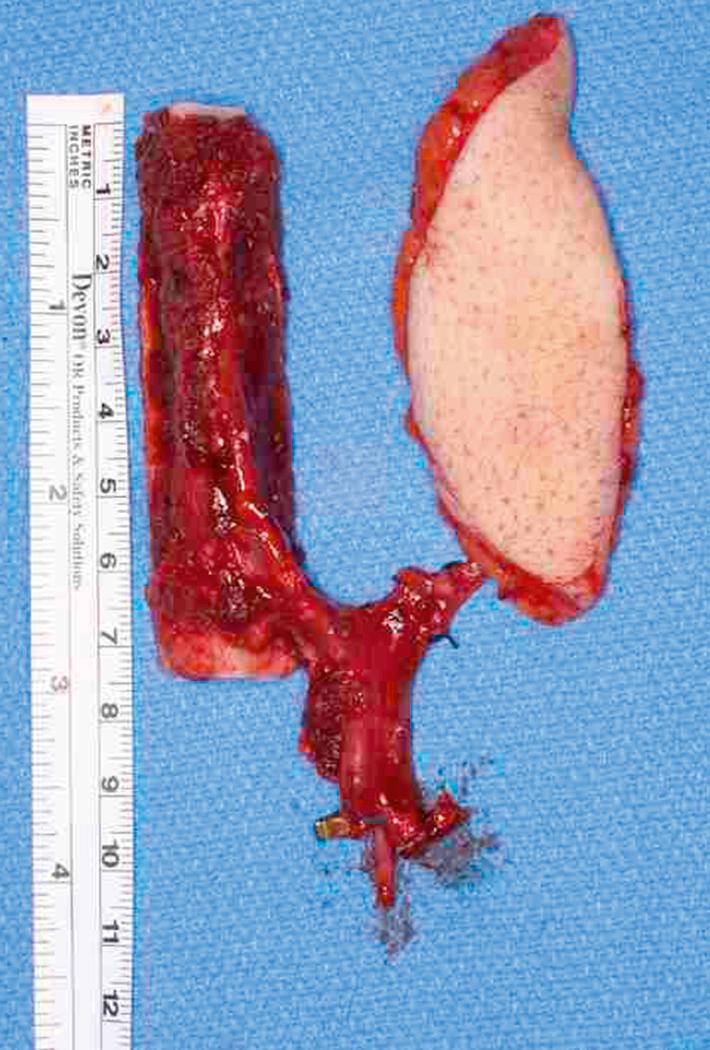
Transfer of vascularized epiphyses may allow continued growth of a limb. This is currently practical only for fibular grafts with inclusion of the entire proximal fibula, or with toe flaps including bone or joint.
Infections represent a particularly difficult problem. Application of systemic or local antibiotics and aggressive debridement of necrotic bone and soft tissue must be carried out until the infection is deemed inactive or eradicated. Criteria commonly used to determine inactive sepsis include an absence of sinus tracts, negative bacterial cultures, a negative C-reactive protein level, and a sedimentation rate of less than 15 mm/hour, maintained for at least 1 month. When strict criteria for determining quiescence are used, recurrent infection will occur infrequently. The use of bone with blood supply serves to further improve local blood supply and likely assists with a successful outcome.
Vascularized bone or osteochondral flaps may be applied to defects of the carpus and hand to aid or accelerate fracture healing or replace deficient bone. However, they have most widely been indicated for revascularization of ischemic bone. The most common instances are scaphoid fractures resulting in proximal pole avascular necrosis, osteonecrosis of the lunate (Kienböck disease), or osteonecrosis of the scaphoid (Preiser disease). They are also indicated when previous conventional surgery has failed or is deemed likely to fail. Bone-only flaps must be used with some caution once subchondral fracture results in damage to the articular surface, or in very small or fragmented scaphoid proximal fragments. In such instances, partial replacement of both deficient bone and a damaged or nonfunctional articular surface has been recently demonstrated in scaphoid nonunions with small or fragmented proximal segments and in avascular necrosis of the lunate. In both circumstances, replacing the proximal half of the lunate or scaphoid to include the radial articular surface may prove to be a viable technique.
Selection of the optimal donor for a vascularized bone graft depends on consideration of a number of factors, including whether material taken from the donor site will match not only the size and shape of the defect but also its material properties. Other considerations include the proximity to the donor area, adequacy of the vascular pedicle for microvascular anastomosis at the recipient site, and donor site morbidity. The most important source of vascularized grafts for large upper extremity bone defects (>6–8 cm) is the fibula. Historically, the iliac crest has been used as well, but its membranous nature, curved shape, and relatively weak mechanical properties make it a secondary consideration in most such instances. Smaller defects, particularly in the hand and wrist, continue to benefit from vascularized bone flaps, as well. Distal radius pedicle grafts taken from either the dorsal or palmar surface have been extensively used for carpal nonunion or avascular necrosis based on well-defined anatomy and flap design. In recent years, the medial femoral condyle (MFC) flap variants, including bone, periosteum, and articular cartilage, , are finding increasing favor in difficult clinical situations. Similar grafts may also be obtained from the lateral femoral condyle.
Corticoperiosteal flaps are superior to other methods in treating failed reconstructions and radiation-induced pathologic fractures of the clavicle. The healing rate and time to union are significantly better in scaphoid nonunions with humpback deformity and dorsal intercalated segmental instability carpal collapse when treated with a large MFC graft. Previously unsalvageable lunates, with damaged proximal articular surfaces, may also be reconstructed with osteoarticular MFC segments. Additional options may include pedicled flaps from the pisiform, , metacarpal head, proximal second metacarpal metaphysis, the distal lateral humerus, and ulnar or radial diaphysis. Free microsurgical transfer is also possible from the iliac crest, lateral femoral condyle based on a lateral superior genicular pedicle, and rib.
Preoperative planning is vital for successful free tissue transfer. The bony, vascular, and soft tissue anatomy of a particular recipient site must be considered, along with factors related to the bone defect itself. For example, the length and location of the bone defect, infection status, amount of soft tissue loss or scarring, and condition of recipient vessels must be determined. The method of bone fixation should be planned in advance. Rigid fixation and/or the use of structural allograft or autograft bone improves stability and thus the rate and extent of union, particularly in long bone diaphyseal and metaphyseal defects. If osteomyelitis is present, extensive debridement of all devitalized bone and adequate preliminary soft tissue coverage are prerequisites before vascularized grafting is considered.
The adequacy of recipient vessels is a paramount consideration. Clinical examination of pulses and the Allen test may be all that is required in nontraumatic cases. In many instances of traumatic or postirradiation bone deficiency, the extent of soft tissue injury extends well proximal and distal to the level of bony abnormality. Within the reactive zone, a patent vessel may be prone to spasm, as well as friability due to surrounding scar or granulation tissue. This will render any anastomosis potentially flawed. In such situations, planning an anastomosis proximal or distal to the zone of injury is necessary. This may be performed with a sufficiently large flap or long pedicle, or at times by the use of vein grafts. Arteriography of the recipient site should be performed if there is any preoperative concern. This is most common in trauma indications, where vascular damage is likely. The probable need for vein grafting may be determined by preoperative arteriography and by consideration of known factors such as pedicle length and distance of bone from available recipient vessels.
Vein grafting may be done as conventional arterial and venous interposition grafts or by fabrication of a temporary arteriovenous fistula. In the latter circumstance, a reversed saphenous vein graft is anastomosed end-to-side to the recipient artery and end-to-end to the vein. End-to-side arterial anastomoses may have a higher patency rate in free tissue transfer and preserve distal circulation. The shunt is allowed to perfuse while the donor tissue is harvested.
The vascularized graft can be placed in either an orthograde or retrograde flow position, as dictated by the position of the best vascular anastomosis. A retrograde position has no effect on patency or rate of union. Bony stabilization is performed, followed by vascular anastomosis. Use of stable internal fixation provides results superior to those of minimal internal or external fixation. , Plates spanning the entire reconstruction, or intramedullary fixation, are optimal. Stabilization may include the use of intercalary allografts. In the upper limb, this is most generally considered for humeral shaft and shoulder arthrodesis reconstructions. Addition of supplemental cancellous graft at junction sites increases the primary healing rate.
Selection of the best donor site is based on a consideration of the recipient site requirements and the characteristics of available donors. Larger defects in the upper limb are generally best reconstructed with fibular flaps, but smaller defects and bone with impaired vascularity or failure to heal with conventional methods may heal with smaller vascularized bone, corticoperiosteal, or osteocartilaginous flaps.
The donor site should be examined for evidence of previous injury or surgery, and an adequate history should be obtained to rule out systemic disease or local closed injury possibly affecting the surgical plan. A vascular examination should be performed, including peripheral arterial pulses. In the case of fibular harvest, vascular anomalies are rare, and adequate perfusion of the foot following harvest has been demonstrated to be nearly normal in most cases. We do not routinely perform angiography unless the examination suggests possible problems. Less invasive methods, such as computed tomography (CT) scanning or magnetic resonance angiography, are proving to be of value.
Thrombosis of the vascular pedicle in a vascularized bone graft results in conditions less favorable for vascular invasion and the usual process of bone graft incorporation than a conventional bone graft. Monitoring of graft viability in the immediate postoperative period is therefore desirable. A variety of methods have been used to assess viability on an intermittent basis for the purposes of planning subsequent treatment and anticipating outcome. These include selective angiography, monitoring of healing and hypertrophy with serial radiographs, bone biopsy or observation of bleeding on subsequent surgery, or early 99m technetium bone scans, generally in the first postoperative week, as well as use of Doppler ultrasound scanning or single photon emission CT scans.
Intermittent monitoring methods, however, will not detect acute thrombosis. Continuous monitoring is possible with the use of a surface or implantable laser Doppler velocimeter or a thermocouple probe, or, most practically, monitoring of a skin paddle serving as a “buoy flap.” Detection of thrombosis allows revision of the anastomosis and salvage of a significant number of failing free tissue transfers.
By far the most feasible and easily interpreted continual monitor is a fasciocutaneous buoy flap. It enables direct observation of the transferred tissue, allowing immediate return to the operating room if loosening of the dressing, altering of the limb position, or trial of anticoagulation does not reverse the observed changes in 1 to 2 hours. Cutaneous island monitoring is possible with most vascularized bone flaps, including the most common fibular, iliac crest, medial femoral condylar, and 1,2 intercompartmental supraretinacular artery (1,2 ICSRA) flaps.
Although measurement of blood flow in an imbedded free flap is difficult, special probes have been used effectively for at least 48 hours postoperatively. In a study by Schuurman et al. of free fibular transfer, an occlusion rate of 10%, with 50% successful salvage was seen with use of a laser Doppler probe. A miniature Doppler ultrasonic probe is also available, designed to be secured to the outflow vein of the flap via a silicone rubber cuff. The device was successful in salvaging 20 instances of thrombosis or spasm in 16 of 135 consecutive free flaps.
Arteriography allows assessment of bone viability at a single point in time. Angiography performed 6 to 8 weeks after surgery, if positive, is suggestive of likely clinical progress.
Experimentally, positive bone scans correlate with vessel patency when done before the end of the first week, prior to the onset of creeping repair in both vascularized and nonvascularized autografts ( Fig. 46.2 ). Use of dynamic imaging provides a more accurate, even semiquantitative, linear relationship between scan values and bone blood flow.
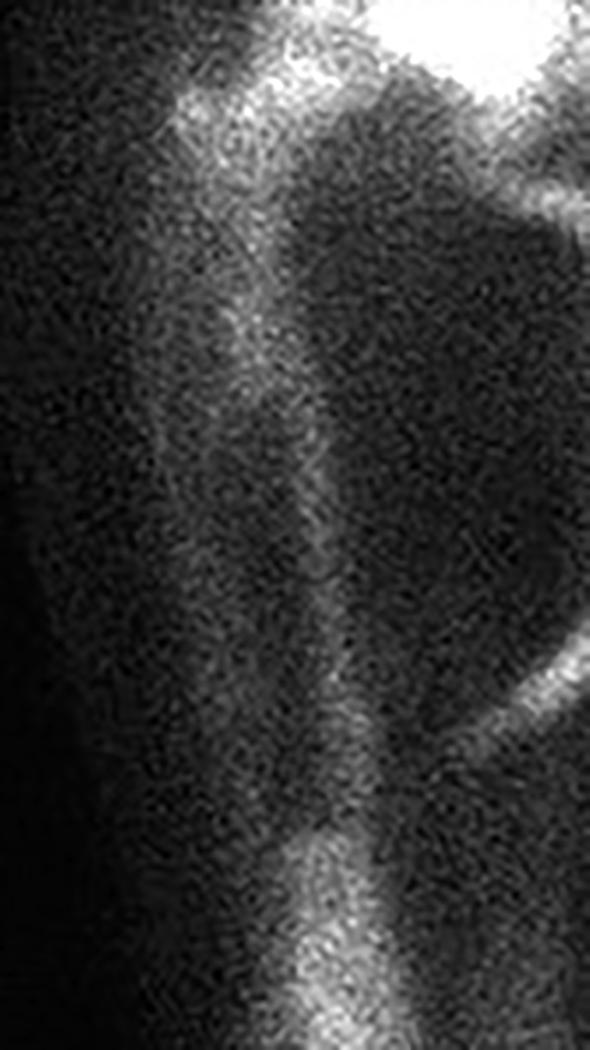
Bone scans obtained in the first 1 to 2 weeks following flap transfer have been demonstrably useful in clinical and experimental studies, correlating well with preserved circulation and clinical outcome. In these studies, patients with a “hot” postoperative radionuclide were more likely to have a successful clinical outcome than those with negative or equivocal scans. In one series, only one of seven patients with poor scans healed primarily, and two cases (almost 30%) resulted in frank failure, necessitating removal of the transferred bone.
Vessel thrombosis occurs in a small percentage of free tissue transfers. If thrombosis occurs in a bone flap, it is likely that the surrounding cuff of necrotic soft tissue may impede neovascularization. Experimentally, the viability of thrombosed vascularized bone grafts is significantly less than that of conventional nonvascularized grafts, as quantified by measurements of bone blood flow, new bone formation, and osteocyte counts. Thus, the process of creeping substitution of necrotic bone is likely less extensive in failed vascularized grafts than in conventional grafts.
Secondary bone grafting will be necessary in a substantial number of patients treated with structural vascularized bone grafts of the long bones. Primary healing occurs in roughly 68% of vascularized fibular grafts, with poorer results in some locations and with a diagnosis of osteomyelitis. Most that do not heal primarily will benefit from a secondary bone graft. Because the mean time to healing is 6 months for fibular grafts and 7 months for iliac crest grafts, timing of a secondary graft is generally somewhat longer, frequently at or before 12 months following the vascularized graft. A largely cancellous autograft at the ununited junction is usually sufficient. Problems associated with insufficient internal fixation may require revision at that time.
Stress fracture of a structural graft spanning a segmental defect may occur in both the upper and lower extremities ( Fig. 46.3 ). , Minami reported an incidence of 12 fractures occurring in 10 of 53 vascularized fibular transplant patients (23%). Rigid stability provided by spanning plates or allograft replacement with intramedullary fixation on only fibular grafts results in a lower incidence of fracture. Healing of stress fractures may occur with immobilization, provided the graft has adequate vascularity. Rapid formation of callus at the fracture site and hypertrophy of the bone is observed thereafter, although displacement is common and requires stabilization.
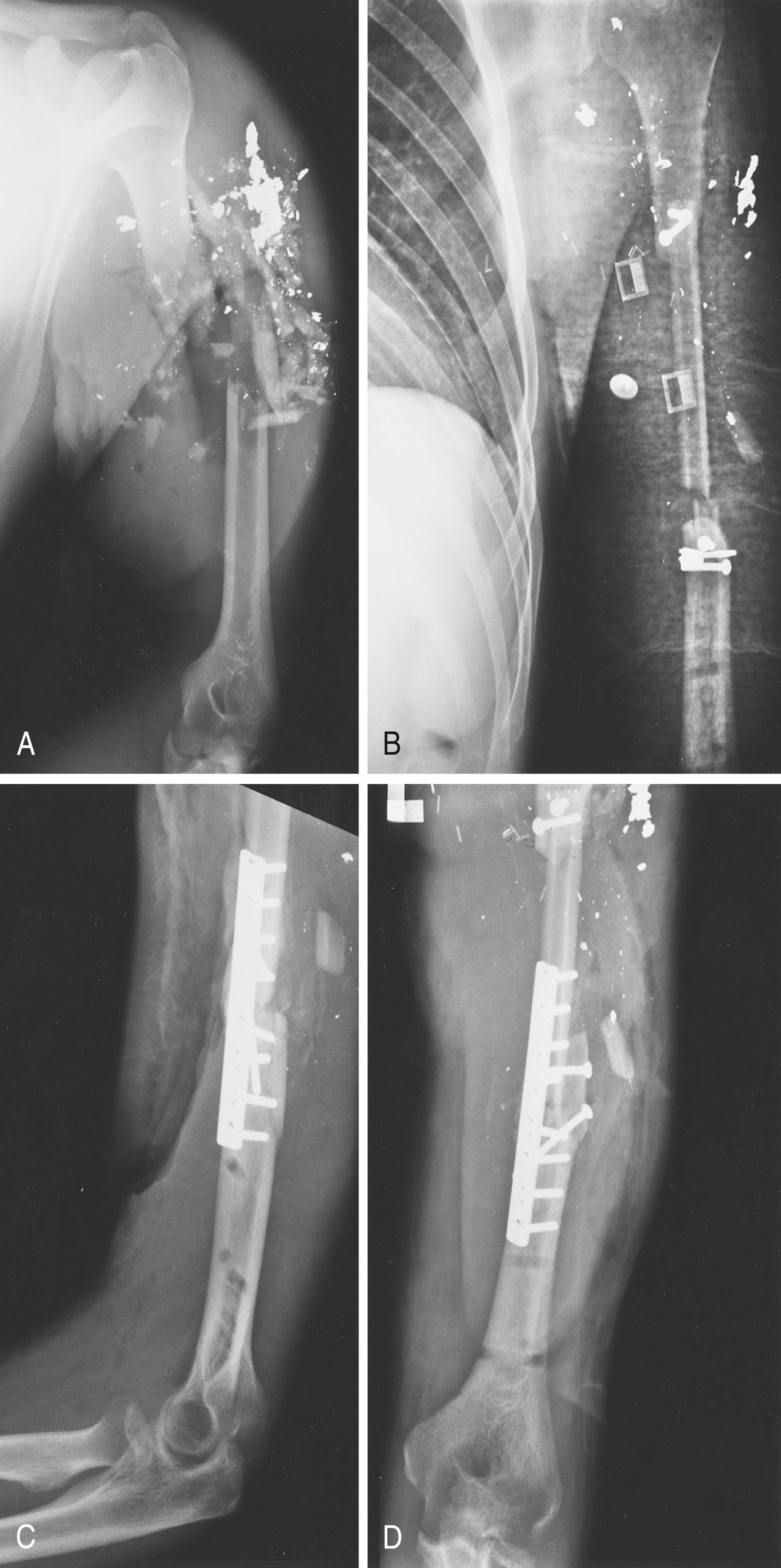
The time of fracture occurrence may be significant because most occur within the first year after grafting. Fractures occurring in this time period generally have adequate circulation, as demonstrated by postoperative bone scanning, but have had insufficient time to undergo hypertrophy. Late fractures are uncommon and are associated with negative or equivocal bone scans. Most stress fractures occur through the transferred bone, rather than at its junctions.
When the fracture occurs in adults, union is often relatively easily obtained. Nondisplaced upper extremity fractures will heal in a cast alone, whereas displaced fractures require internal or external fixation, with or without bone grafting. , A vascularized graft should be protected against fatigue fracture during the first year, allowing a gradual increase in mechanical loading, which enhances remodeling and hypertrophy.
Vascularized Fibular Grafts
The fibula is the most used vascularized bone graft because its structure and shape are appropriate for diaphyseal locations. A long, straight segment of 26 to 30 cm in length may frequently be harvested and osteosynthesis securely obtained to the recipient bone.
The blood supply to the fibula, as in other long bones, is derived normally from a nutrient artery via radially oriented branches, which penetrate the cortex and anastomose with the periosteal vessels. The source of the nutrient blood supply is a branch of the peroneal artery, generally entering the bone in its middle third. The resulting blood flow is centrifugal from medulla to cortex. This arrangement is the norm for the fibula, which has a single nutrient vessel entering its middle third from the peroneal artery. Additional periosteal branches from the peroneal and anterior tibial arteries also supply the diaphysis.
The proximal epiphysis is supplied by an arcade of vessels, including the lateral inferior genicular vessels and a recurrent branch from the anterior tibial artery. Although some recommend use of the genicular blood supply, recent studies support the use of the anterior tibial vessels, which will also support the proximal two thirds of the diaphysis via the periosteal supply. Such a pedicle supplies adequate vascularity to provide either longitudinal growth in children or viable articular cartilage for joint reconstruction. Although the genicular pedicle will provide periosteal blood flow, the peroneal vessels must be separately identified and supply the fibular shaft.
Transfer of a fasciocutaneous skin paddle of up to 10 by 20 cm is made possible by a series of fasciocutaneous or myocutaneous perforators from the peroneal artery, which typically pierces the soleus muscle adjacent to the lateral intermuscular septum ( Fig. 46.4 ). The location of the perforators may be determined in the operating room prior to skin incision by use of a Doppler ultrasound stethoscope. Osteomuscular flaps, including the flexor hallucis longus muscle and portions of the soleus or peroneal muscles, may also be raised using the same peroneal artery pedicle.
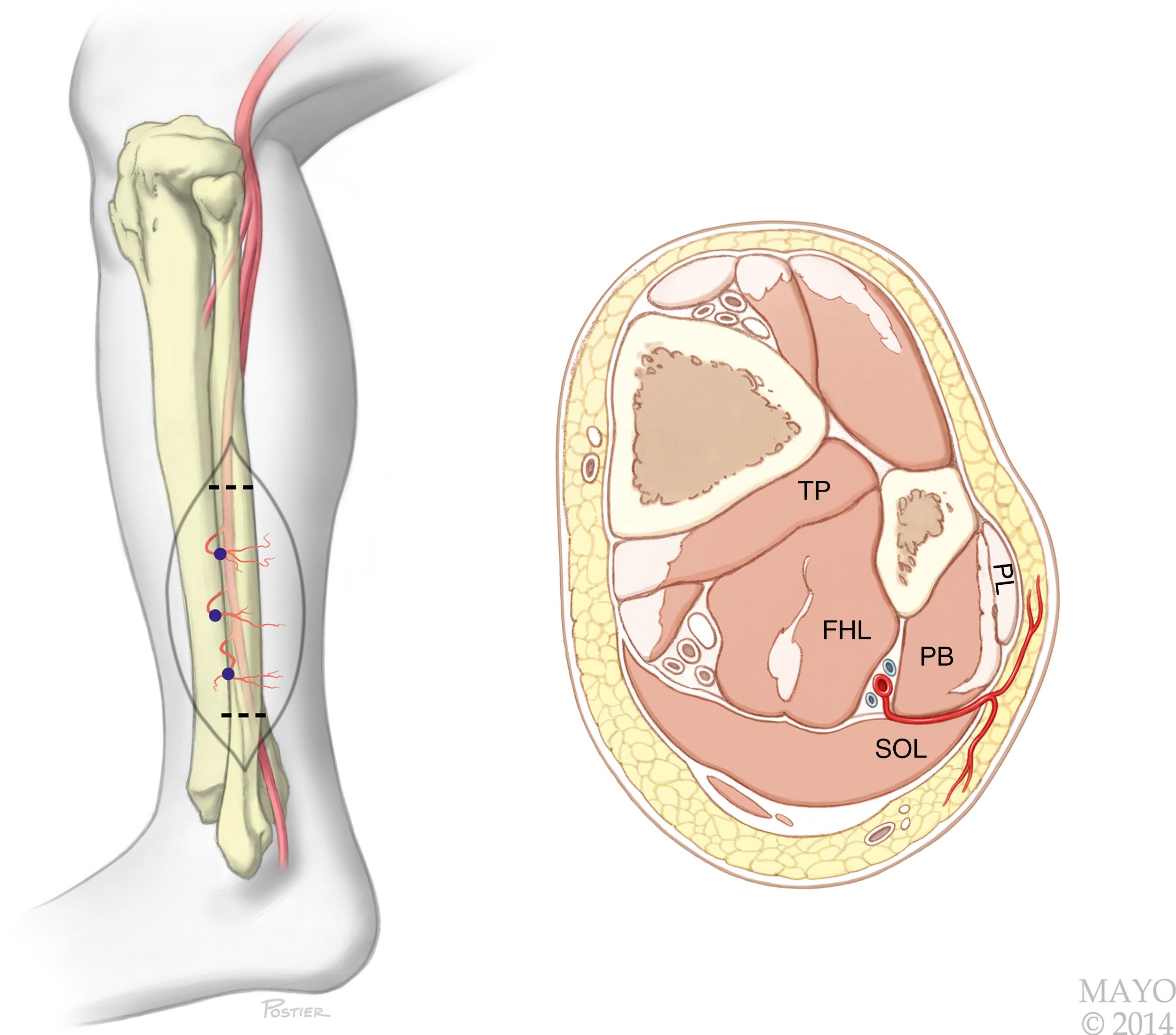
The peroneal pedicle has a length of 6 to 8 cm and an arterial diameter of 1.5 to 3 mm. Two venae comitantes lie on either side of the artery. Variations in the vascular anatomy of the leg are infrequent and include unusual deviations in the course of the peroneal vessels or its prominent contribution to the blood supply of the foot.
Two methods of fibular harvest have been described, including the original posterior approach developed by Taylor et al. and the preferred lateral approach of Gilbert, described below with some modifications. Exposure must protect the peroneal vessels, which lie between the tibialis posterior and flexor hallucis muscles (see Fig. 46.4 ).
The patient is positioned supine, with a small sandbag beneath the ipsilateral buttock and another secured to the table near its foot to allow the patient’s foot to rest securely with the knee flexed. The entire leg is draped free. Next, a pneumatic tourniquet is inflated. The fibula is measured, and its middle third identified. An incision is made directly along the fibular longitudinal axis laterally, extending through skin and subcutaneous tissue ( Fig. 46.5A ). The anterior border of a skin flap is incised at this step. This exposes the broad tendon of the peroneus longus, which is easily identified. A fat stripe posterior to the tendon identifies the interval between the peroneus longus muscle and the soleus muscle. This interval is developed with blunt dissection, beginning in the middle third of the bone (see Fig. 46.5B ). The cutaneous vascular perforators supplying the skin may be visualized at this point passing either through the lateral intermuscular septum or, more commonly, through the adjacent anterior centimeter of the soleus. As the soleus is reflected posteriorly, one can identify the flexor hallucis muscle belly covering the posterior surface of the bone and obscuring the peroneal vessels from view.
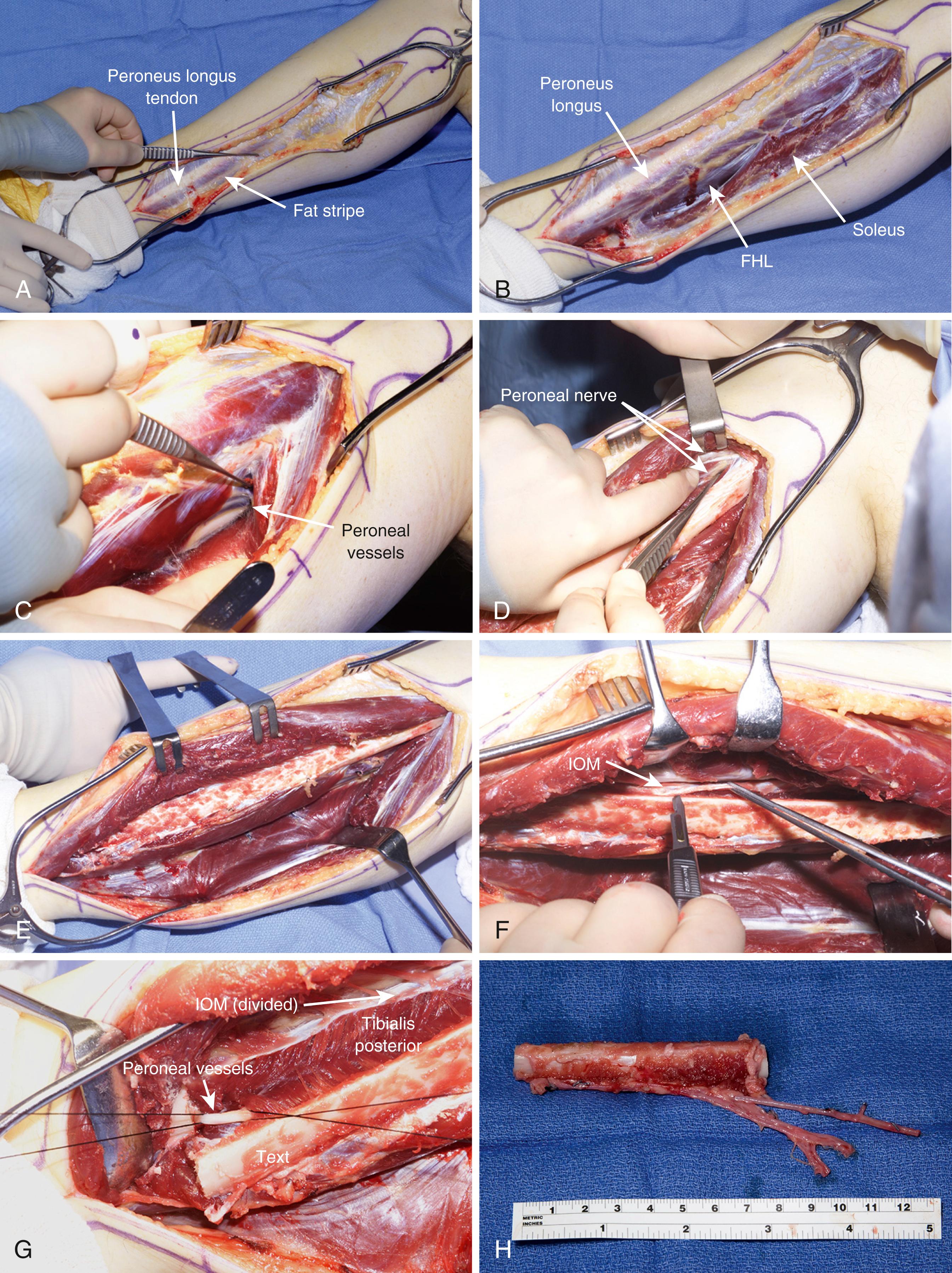
The flexor hallucis longus (FHL) muscle origin lies well distal to the fibular neck. Proximal to the muscle, the peroneal vessels are identified as they pass deep to the FHL origin (see Fig. 46.5C ). The vessels should be mobilized carefully from the posterior surface of the fibula to prevent their inadvertent injury when the bone is divided.
Dissection is continued progressively proximally, elevating the soleus tendon of origin from its fibular attachment. Muscular branches of the peroneal vessels to the soleus will be visualized during the dissection and should be ligated and divided unless a composite osteomuscular flap with the soleus is desired. The soleus is completely detached from the proximal fibula.
Next, the lateral compartment muscles are elevated from the fibula. Proximally, this must be done subperiosteally to avoid injury to the peroneal nerve. The nerve must be visualized and protected at this proximal level, lying directly on the bone of the fibular neck and proximal diaphysis (see Fig. 46.5D ). As the muscle is elevated in a distal direction, the superficial branch of the nerve lies further from the bone, and an extraperiosteal dissection plane will better preserve the bone blood supply. This dissection should leave small occasional wisps of muscle rather than a large muscular cuff on the bone surface because this will form a necrotic barrier to revascularization should the anastomosis fail (see Fig. 46.5E ).
The anterior compartment is elevated similarly. Again, care is needed proximally to protect the deep branch of the peroneal nerve. The anterior tibial artery will be identified, as will the interosseous membrane at the conclusion of this dissection. Depending on ease of visibility, the interosseous membrane may be divided at this point (see Fig. 46.5F ) or the bone divided proximally and distally first. Bone division is carried out with a Gigli saw, protecting neurovascular structures with careful circumferential retraction and blunt passage of the saw cable. The middle third of the bone, at a minimum, must be raised to preserve the nutrient artery supply. Harvesting more of the proximal third will improve visualization of the peroneal artery pedicle at the conclusion of the graft elevation. Although the entire proximal fibula may be harvested if articular surface or physis is required, 7 to 8 cm of the distal fibula should be preserved to prevent valgus instability of the ankle. In children, a distal tibiofibular syndesmotic fusion is necessary with an iliac crest interposition graft and screws to prevent ankle instability ( Fig. 46.6 ). Fusion is not necessary in adults.
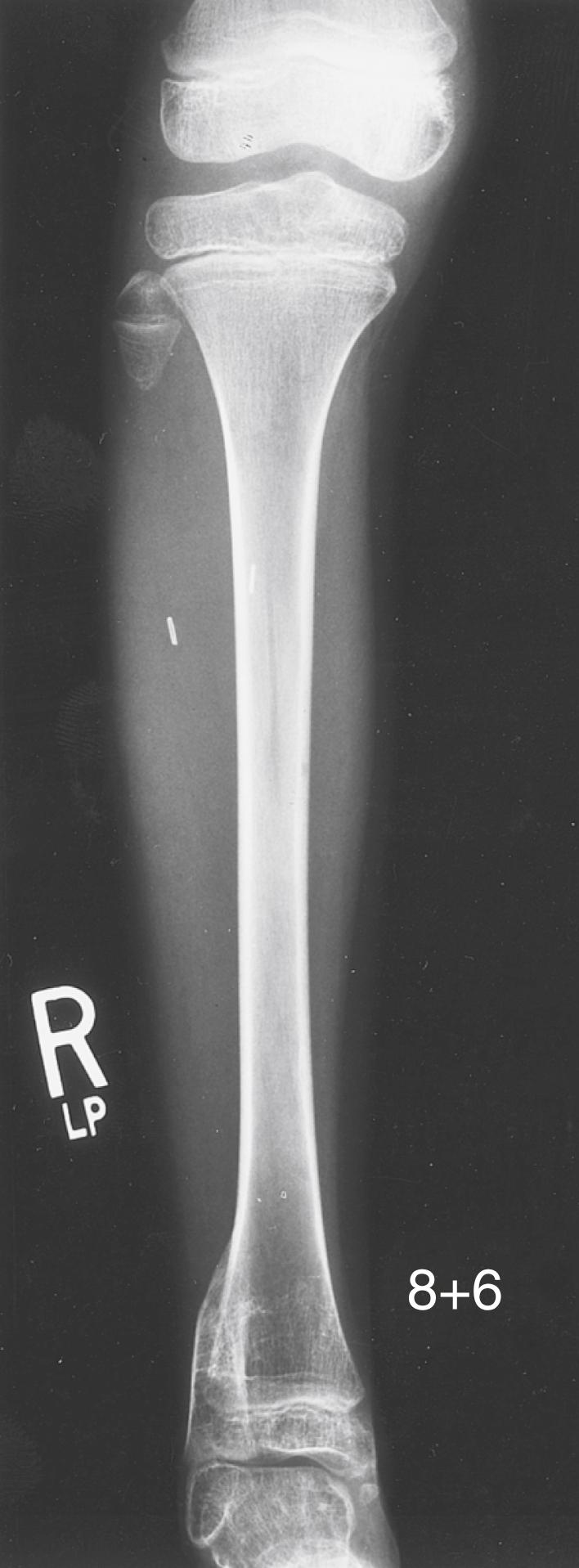
After the interosseous membrane and bone are divided, the peroneal artery is identified at the distal osteotomy and ligated (see Fig. 46.5G ). A long suture tag is left on the proximal stump to facilitate proximal dissection of the vessel. Dissection proceeds from distal to proximal. Viewing the fibula from a dorsal direction, the muscle of the tibialis posterior muscle is now exposed after division of the interosseous membrane. The tibialis posterior muscle and posterior fascia must be divided to expose the peroneal vessels. The muscle is teased away carefully first, ligating muscular perforators as they are encountered. A tissue plane is identified just anterior to the ligated peroneal vessel. This is the posterior fascia of the tibialis posterior, which is next divided to expose the artery. The dissection must be meticulous to identify and ligate multiple muscular perforators and protect the underlying vessels.
At this point, only the vascular pedicle and the FHL muscle belly remain attached to the bone. The FHL tendon may be divided at this point if the muscle is to be included with the fibula as an osteomuscular flap. In most cases, it is not, and the FHL is carefully incised at its fibular origin, protecting the peroneal vessels at all times. Additional perforators will frequently require ligation.
Finally, the peroneal pedicle is dissected as far proximally as possible. Separation of the artery and venae comitantes from each other is desirable at this time. At this point, they form the sole remaining attachment of the fibula. The tourniquet is released, and the bone is allowed to perfuse while careful hemostasis is obtained in the leg. The artery and veins are ligated proximally and divided to detach the flap (see Fig. 46.5H ). Two suction drains are placed, one between FHL and the soleus, and another subcutaneously. The FHL is loosely repaired to the peroneal muscle with a running absorbable suture. The skin is closed in layers.
Osteocutaneous flaps are often advocated because the skin serves as a visible and immediate monitor of peroneal vascular patency. At times, the skin is needed to enable wound closure without tension and provide coverage for the underlying fibula and vascular reconstruction. Inclusion of skin is made possible by several fasciocutaneous perforators from the peroneal artery, which supplies the skin at intervals, particularly along the middle third of the bone. If a cutaneous flap is elevated with bone, the locations of the major fasciocutaneous perforators are identified with a Doppler ultrasound stethoscope prior to tourniquet elevation because their exact position and number vary considerably between individuals. They may be readily identified midlaterally by an audible pulse using the probe, near the soleus/peroneal junction (lateral intermuscular septum). Alternatively, the exact placement of the skin island can be determined by visualization of the vessels directly after the anterior incision is made. The dissection proceeds exactly as for a conventional fibular graft, except that the peroneus-soleus interval is left undisturbed in the middle and distal thirds until the peroneal vessels are exposed anteriorly (after fibular osteotomies, and division of the tibialis posterior). Isolation of the perforating vessels is performed by division of the posterior skin flap at this point, and their mobilization back to the peroneal vessels. To avoid problems with excessively tight skin closure and compartment syndrome, the donor site at the skin paddle area should be closed by a split-thickness skin graft, unless a very small buoy flap only is taken.
Inclusion of the proximal growth plate to allow for growth of the transferred bone is a reasonable procedure when no other options exist. In a leg with normal vascular anatomy, current opinion favors the use of the anterior tibial vascular pedicle, which will support the fibular head and neck with a nutrient vessel supply, and a periosteal supply to the diaphysis. The technique of harvest is well described by Innocenti. It is most used in the upper limb for restoration of growth following resection of the distal radius in children, , but it is also useful with resection of the proximal humerus or distal ulna.
A longitudinal incision centered between the tibialis anterior and extensor digitorum longus is prolonged proximally, following the biceps femoris muscle. Dissection in the intermuscular plane between these two muscles, starting distally, exposes the tibialis anterior neurovascular bundle and preserves the delicate network of periosteal vessels supplying the diaphysis. During proximal dissection, many motor branches of the peroneal nerve cross the operating field, and they must be carefully preserved.
The common peroneal nerve is identified and protected at the level of the fibular neck. The origins of the extensor digitorum longus and peroneal muscles are incised and reflected laterally and inferiorly 2 cm distal to the proximal fibular tip, leaving a muscular cuff surrounding the fibular epiphysis. Once the vessels are isolated, the fibular head is released by division of the biceps femoris tendon and iliotibial band attachments and release of the lateral collateral ligament and tibiofibular joint capsule. The anterior tibial vessels may be ligated at their origin to complete the harvest.
The fibula may be harvested with inclusion of the lateral portion of soleus and/or the flexor hallucis muscle. The FHL provides only enough muscle to cover the distal fibular segment. It is easily harvested by dividing its distal tendon rather than by separating the FHL from the fibula at its origin.
A larger muscle, sufficient to obliterate dead space or provide coverage, may be preferred. In this instance, use of the lateral portion of the soleus is appropriate. This is also easily accomplished by sparing the soleus muscular branch(es) visualized during exposure of the peroneal pedicle early in the dissection, as described previously. Once one or more of the muscular branches is identified and spared, the dissection proceeds unchanged until the end of the elevation, when the soleus is divided longitudinally in its midsubstance. The tibialis posterior artery and tibial nerve are carefully protected during this process.
Strength can be improved particularly for femoral applications, or two segments can be separated sufficiently to allow simultaneous reconstruction of the radius and ulna, by use of a double-barrel graft. Following harvest, the free fibula graft is osteotomized at its midpoint, the surgeon having first gently elevated and separated the peroneal vessels from the bone at the osteotomy point. This produces two vascularized bone grafts that require only one set of anastomoses. This folded fibula provides twice the cross-sectional area of a single fibula transfer when placed in a single bone. For forearm use, resection of a short intercalary segment of fibula will increase the separation of the proximal and distal segments of bone without tension on the spanning vascular bundle for reconstruction of both forearm bones. An effort should be made to ensure that one of the segments is vascularized by both a periosteal and an endosteal blood supply, including the nutrient vessel. In most cases, this will be the proximal segment; the distal segment will therefore be vascularized by periosteal vessels alone.
Become a Clinical Tree membership for Full access and enjoy Unlimited articles
If you are a member. Log in here